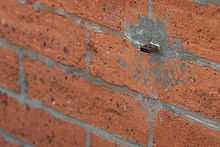USB dead drop

A USB dead drop is a USB device installed in a public space. For example, a USB flash drive might be mounted in an outdoor brick wall and fixed in place with fast concrete.[1] The name comes from the dead drop method of espionage communication. The devices can be regarded as an anonymous, offline, peer-to-peer file sharing network.
An early USB dead drop network of five devices was started in October 2010 in New York by Berlin-based artist Aram Bartholl,[2][3] a member of New York's Fat lab art and technology collective. A similar "deadSwap" system has been run in Germany since 2009.[4]
Members of the public are invited to drop or find files on a dead drop by directly plugging their laptop into the USB stick in the wall to share files and data. It is possible to use smartphones and tablets computer by using a USB on the go adaptor.
Each dead drop is installed empty except two files:[5] deaddrops-manifesto.txt,[6] and a readme.txt file explaining the project.[7]
Pros and cons
Pros
- Opportunity to practise Datalove (word invented by Telecomix)
- Sharing files with another person secretly.
Cons
Publicly and privately available points give anyone the ability to save and transfer data anonymously and free of charge. Such offline networks are vulnerable to the following examples of threats:
- A fake dead drop might be rigged up to electrically damage any equipment connected to it, and/or constitute a health and safety hazard for potential users. This risk can be amended by using a USB galvanic isolation adapter, which allows data exchange while physically decoupling the two circuits.
- Software destruction: anyone can erase all of the data by file deletion or disk formatting, or by encrypting the data or the whole drive and hiding the key (ransomware).
- Malware: anyone can intentionally or unintentionally store malware on it that can infect an attached computer with malware such as a trojan horse, keylogger or proprietary firmware.
- Vandalism of the dead drop by physical destruction: anyone can destroy the dead drop by using for instance pliers or a hammer, by high voltage from a static field, with high temperature from a blowtorch, or other methods of physical force. It is possible to make the USB key more difficult to vandalize or to extract, by sealing it in a hole deeper than the length of the USB key (at least 2 cm more), this requiring to connect only a USB extender cable of type female-male (standard type A). Sometimes the dead-drop itself can be vandalism of the building.
- Disclosure: anyone can disclose the location of a private dead drop by shadowing people and publishing coordinates in a public place.
- Demolition: certain dead drop locations are limited to the lifespan of public structures in local areas.
Around USB dead drop
In 2013, the web site instructables publish (text and video) how to make a USB dead drop in nature.[8]
Wireless dead drop
Following this concept, wireless dead drops are being created.[9][10][11] The PirateBox, designed in 2011, is the best known.
See also
References
- ↑ "How to make your own". Deaddrops.com. 2013-06-10. Retrieved 2013-06-25.
- ↑ Hern, Alex (8 March 2015). "Dead Drops: what to do if you see a USB stick sticking out of a wall". The Guardian. Retrieved 9 March 2015.
- ↑ "Dead Drops: Bizarre new artwork embeds USB sticks in buildings". Mail Online. 3 November 2010.
- ↑ http://deadswap.net/files/deadswap.pdf
- ↑ http://www.instructables.com/id/Create-a-USB-Dead-Drop-in-Nature/?ALLSTEPS
- ↑ http://deaddrops.com/download/deaddrops-manifesto.txt
- ↑ http://deaddrops.com/download/readme.txt
- ↑ http://www.instructables.com/id/Create-a-USB-Dead-Drop-in-Nature/?ALLSTEPS
- ↑ "PirateBox".
- ↑ "WIDROP".
- ↑ "Wireless drop".
External links
| ||||||||||||||||||